www.BadgerTrek.comAbout/ContactWeb LogOur Camper Van
Resources:Hobbies:MotorcyclesAmy's CakesOutboard Hydroplane RacingRadio Controlled Toys |
Computation and Connectivity...
Computers are wonderful things, as is the internet and the communication possibilities it provides. For us, our current lifestyle is reliant upon them in a number of ways, and they have also dictated some of our requirements and modifications to the van (e.g. power system).
The laptops we chose for our trip are two Dell Inspiron 700m units. They are small enough to fit easily in a day-pack (for visiting coffee shops or doing some work after hiking out somewhere), the video resolution is great, they have a reasonable sized screen (bit over 12" diag), and the battery life is about 4 hours per (and we have 4 batteries to share). Since we have two of the same model we can share batteries, power supplies, etc.
For Amy's graphics arts, mass data storage, movies, games, and other tasks to which the laptops are not ideal (small screen, small hard-drive, etc) we have a semi-permanently mounted "main" computer that sits in a cabinet. All of the components were chosen to be low-power and preferably run off of 12v directly so that we don't need to run the inverter to power them (there are significant inefficiencies in up-converting 12vDC to 120vAC, and then back down). The computer runs a laptop chipset and CPU (in fact, the same as used in our laptops), the power-supply is just a DC-DC converter from mini-box.com. Inside the computer are 2 250gig hard drives. For external storage we have 4 250gig drives in USB enclosures, one each for Amy's art, Erik's work data, movies, and music archives. These can be used by either the main box or one of the laptops as needed.
The monitor for the "main" box is a 21" LCD flat panel with 1600x1200 resolution powered directly from the 12v system as well. The monitor is suspended from the roof rail (steel put in place where the roof was cut out for the penthouse) by a large RAM mount with a 13" arm. The RAM mounts allow us to rotate the monitor to face the sofa, the reversed passenger chair, the back of the van (for when you need to go, but also need to email), or to face the wall so that the screen is out of the way and protected from the dings of daily life.
We have a passively cooled nVidia 6800 PCIx 3d video card, but usually have it out of the computer to save power, and just rely on the chipset's built in video.
Since both Amy and I derive our income from computer related professions, network connectivity was a must for this trip. Satellite internet access has reached an economical and useful enough form to allow us to stay online from nearly everywhere. We have an account through Starband, a satellite dish, tripod, and the required modem and TX/RX electronics to get online. The satellite link also provides a bit of security in the form of communication if we ever get stranded or injured in the boonies, and cannot drive ourselves out. VOIP through Skype or other providers works well enough to make calls into the telephone network, albeit with a bit of a delay. |
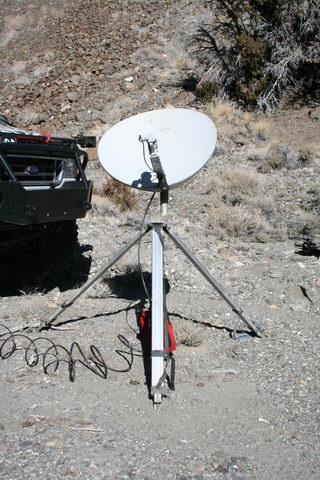 |
Usually I can get the system assembled, pointed at the satellite, and online within about 15 minutes after a few months of daily practice. Most of the time is spent un-lashing the tripod from its carrier and bolting together the pieces.
Bandwidth varies, but is usually about 500kbps down, 90kpbs up. This is pretty good, but the latency is where we get killed. Pings range from just below 1sec to about 3 sec, and sometimes even longer. This kills for some applications, such as VPN (Virtual Private Network) or RDP (remote desktop protocol). Unfortunately I have to do most of my work over RDP over VPN which can be quite frustrating at times. I am getting tools and software setup to reduce the problems this causes, but it keeps this from being a "perfect" solution.
Another slight nit I have with the Starband system is the modem. It consumes a fair amount of power (about 30w), but also has an integrated power-supply, so I cannot take direct advantage of the 12v system in the van, and have to run an inverter, effectively adding another few watts to the cost of going online. We have picked up a small 75watt cigarette lighter type inverter to drive the modem, which reduces the overhead (running a 1500watt capable inverter draws about 7 watts itself) by a few watts.
To connect the various computers in and around the van we have an 802.11b/g wireless router connected to an omni-directional high-gain antenna mounted on the roof. When the modem is connected to the router, and the router is powered on (straight 12v here) we can get onto the net (or do inter-computer transfers) with the laptops from pretty much anywhere line-of-sight within about 1/2 mile of the van. 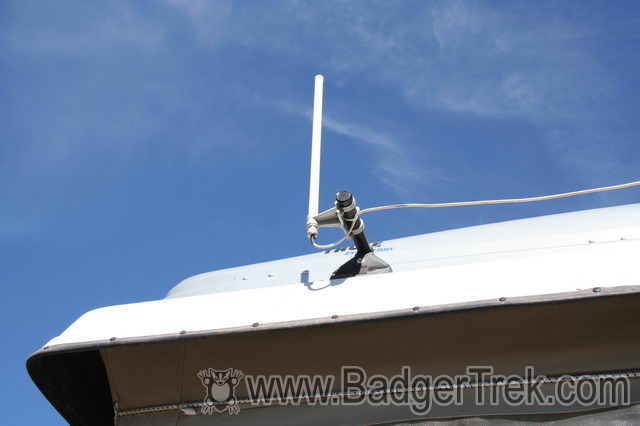
If we are in town, and don't have the dish out, we can hook the antenna directly up to a wireless card in the main box, and usually find at least one open access point that will give us an address and let us online.
In February of '06 we added Verizon EVDO and 1xRTT cell data access to our list of nerdy internet accessing abilities. Through a PC card (PCMCIA) and an antenna mounted on our roof we can pick up a data signal from a cell tower near most populated areas and major freeways. Depending on location the bandwidth is anywhere from about 1.5mbps to 80kbps down, which varies more than the satellite, but the latency is an order of magnitude less, making many work tasks significantly easier and less frustrating even when the throughput is low. The uplink is not a very big pipe, but does beat a regular dial-up modem, and we rarely have huge chunks of data to send up-stream.
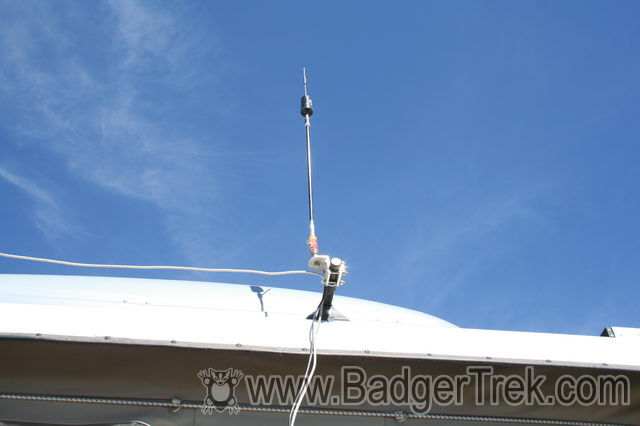
For navigation we rely largely on two tools: The set of state-by-state Atlas & Gazetteers published by DeLorme, and DeLorme Topo USA
(we use to use Microsoft Streets & Trips, but Topo USA has more roads, trails, and topographical data) with a GPS antenna attached to a laptop. The Gazetteer is useful for finding nice scenic areas, landmarks, out-of-the-way roads, and giving a general overall look of what places to visit (the "where to go"). Topo USA on the computer can plot out a route, and then show us where we are in real-time as we drive just like one of those new fancy (and really expensive) navigation computers some cars come with (the "how to get there" coupled with the magical "You are Here").
Once we know where we want to go, we put the destination, and any desired way-points, into the laptop and have the software highlight the route and then follow the route using the GPS (often we ask it to try to avoid major freeways, highways and have preference for minor, out-of-the-way roads which tend to be more scenic, leading to spontaneous decisions to "go that-a-way" when we see something interesting.
The laptop is mounted on a swivel mount attached to the console between the driver & passenger seats. The mount consists of a set of 3 RAM mount components, the top of which is a flat plate covered in Velcro. Each of our laptops has complimentary Velcro on the bottom and they have stayed put through quite the beating on 4x4 roads. Under the flat plate is some more Velcro for holding the laptop 12v DC-DC power-supply so the laptop will stay on and charged when we drive.
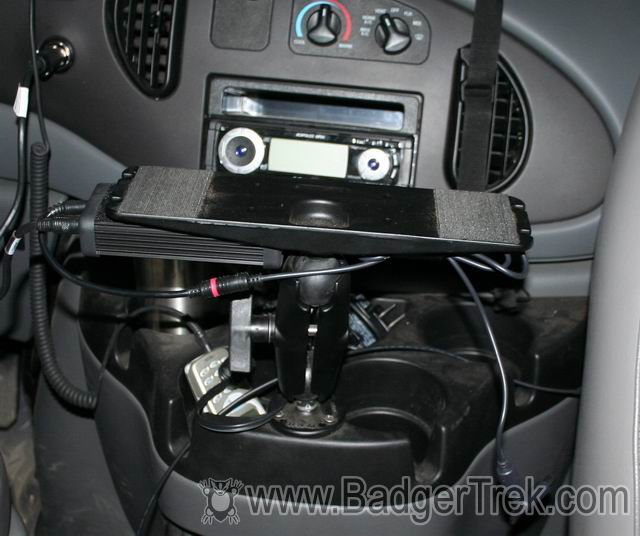
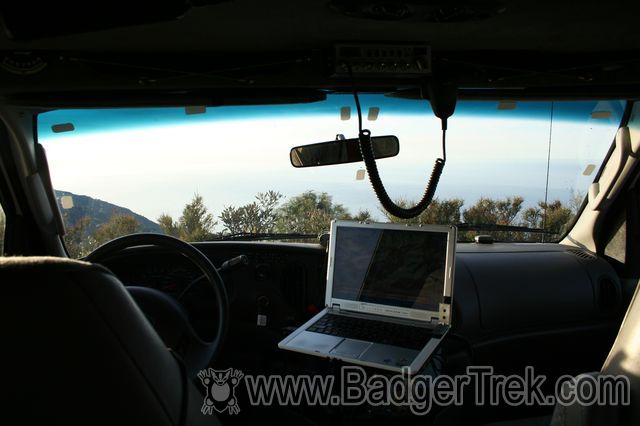
For the GPS antenna we initially bought a 35$ Holux USB GPS "mouse" off of eBay to see how well it worked. There are much more expensive antennas out there, some of which mount on the roof, or have much fancier statistics, but this has proven quite capable and much cheaper. The antenna is unobtrusive, fits on our dash, and consistently locks on and tracks our position without flaw. Accuracy is enough to often tell which side of the road we are on.
When we are online another useful resource is Google Earth. With the satellite views we can often spot nearby trails and interesting land features that are not in our other maps or software. It also is a nifty way of sharing a bit of our view with friends via an email with the GPS coordinates and they can get a virtual view of the surrounding area.